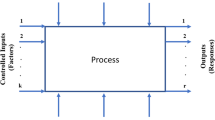Abstract
This paper describes the verification of the accuracy of residual stress measurement by the hole-drilling method. The strain measurement is simulated by the use of the indirect fictitious-boundary integral method. As an example, a finite rectangular plate subjected to initial stress is treated, and a simulated measurement of the residual stress is made using the strain relieved during hole drilling. The accuracy of residual stress measurement is estimated by comparing the simulated measured residual stress with the actual residual stress, i.e., the given initial stress. The results are shown for various distances and angles of strain gages. Also, the influences of the eccentricity of the hole from the center of the strain gages and the effect of a boundary near the hole are examined.
Similar content being viewed by others
References
Kabiri, M., “Nonuniform Residual-stress Measurement by Hole-drilling Method,” EXPERIMENTAL MECHANICS,24,328–336 (1984).
Timoshenko, S.P. andGoodier, J.N., Theory of Elasticity, 2nd ed., McGraw-Hill, New York, 78 (1951).
Tuzi, Z., “Effect of a Circular Hole on the Stress Distribution in a Beam under Uniform Bending Moment,”Phil. Mag. Ser. 7,9 (56),210–224 (1930).
Kishida, M., “On Fictitious-boundary Method in Boundary Integral Methods,”Theoretical Appl. Mech.,28,139–151 (1980).
Kishida, M. andHonma, K., “Comparison of an Elastic Cylinder between Two Rigid Planes (Application of the Indirect Fictitious-boundary Integral Method to the Contact Problem,”Bulletin JSME 26,733 (1983).
Kishida, M., Sasaki, K., Oda, K., Hashimoto, Y., andIn-nami, M., “Application of Indirect Fictitious-boundary Integral Method to Thermal Stress Problems,”JSME Int. J. Ser. 1,32 (4),514–520 (1989).
Author information
Authors and Affiliations
Rights and permissions
About this article
Cite this article
Sasaki, K., Kishida, M. & Itoh, T. The accuracy of residual stress measurement by the hole-drilling method. Experimental Mechanics 37, 250–257 (1997). https://doi.org/10.1007/BF02317415
Received:
Revised:
Issue Date:
DOI: https://doi.org/10.1007/BF02317415




